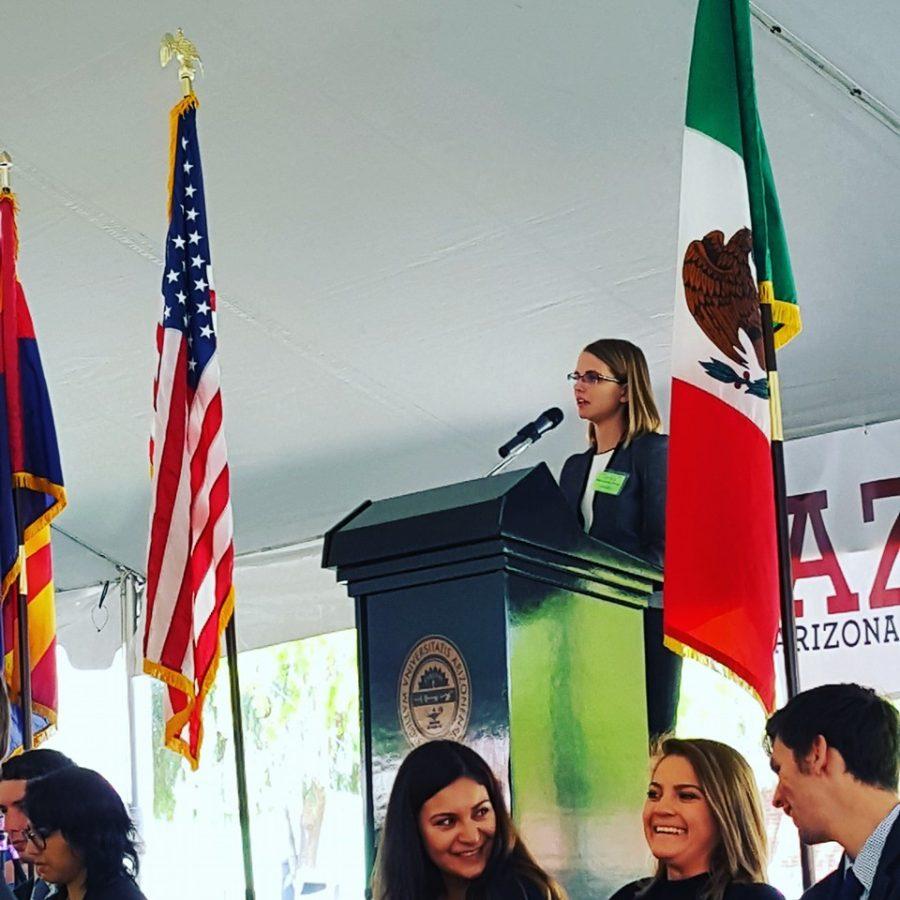The only binational and bilingual Model United Nations high school conference in the country occurred on the UA campus just a few weeks ago. In addition to high school students from the United States, nearly 300 students from Sonora and Chihuahua, Mexico, attended the conference to learn from the students who put the conference together: the Arizona Model UN.
The club, a group of about 84 students who meet weekly or biweekly, works in committees to oversee the conference. All efforts are to ensure the conference runs as smoothly as possible, according to Dino Kadich, a geography sophomore and Secretary General of Internal Affairs for AZMUN.
Kadich attended the conference three times when he was in high school and was able to see both sides of the event: attending the conference and running the conference.
“[As an attendee] you really don’t realize how hard the people who run the conference work for you,” Kadich said. “It’s a huge thing that we put on by ourselves. We take on the burden. It’s a labor of love, 100 percent.”
Some of that work is with translation between English and Spanish at the conference. As a bilingual conference, there are extra hurdles to the debates, but this binational aspect can create new opportunities for the students involved.
“They use this as an opportunity not only to do what we do, which is build a community with each other, learn these awesome public speaking skills, have a good time while learning stuff, but also, this is a great opportunity for them to practice their English,” Kadich said. “So you think about how difficult it is how to learn Model-UN speak as a native English speaker, for them it’s this huge challenge. I imagine it’s amazingly rewarding when they go up there and they do really great because they’ve practiced so hard.”
The 2015-2016 charter for AZMUN lists facilitating “bi-national [sic] dialogue and cooperation” as one of the club’s purposes, but this is just one facet of what the club does.
Besides holding a conference for high school Model UN students, AZMUN also attends conferences to compete with other colleges. Students are assigned a country about a month or two in advance and are given topics for their debates, according to Eleanor Allen-Henderson, an undeclared freshman and member of AZMUN.
Students then research their assigned country’s viewpoint on the topics and go into debates at the conference committees hoping they achieve their goals to help their countries while working with other countries and seeing where they stand.
One of the major conferences AZMUN attends is in Chicago every fall. Every member goes to this conference, regardless of their financial need, according to Kadich, because they offer scholarships for it. More than 1,000 students from different colleges attend the conference in Chicago.
Though AZMUN doesn’t have to go through the work of hosting a conference when going to Chicago, the process of getting there requires plenty of coordination.
“Logistically, I’m so impressed with our team because you have to coordinate all these flights and put people together in flight groups so that they can hold each other accountable and get to their flights on time and get from the airport to the hotel OK,” Kadich said. “Just like getting everyone’s information, their deans’ excuses and putting together a travel guide. … It’s a whole mess, but we’re pretty good about putting it all together and making it work very polished, even though we’re sort of freaking out in the background.”
Once in Chicago, the students can experience college-level competition in a different way.
“One of the things about Chicago is the body votes on who wins, versus the chair chooses the winner and so that kind of makes it less competitive,” Allen-Henderson said. “So you’re more encouraged to cooperate. The way you win is by being nice to people versus modeling to a chair.”
Besides the Chicago conference, AZMUN students also attend a spring conference, sometimes in Montreal or, this year, Los Angeles, Kadich said. Not all of the club members attend this conference, though, because of its proximity to the end of the semester.
In between conferences, the club meets to practice debating, sometimes debating silly topics such as Beyoncé versus Nicki Minaj. These debates are to help members become more comfortable with debating, as well as to get to know each other better, according to Kadich.
“I think that the greatest part of Model UN is finding a family at the UA of people who care about the same things as you and with who you can hold these really important and interesting and well-needed conversations about politics and feminism and things that are going on,” Kadich said.
These kinds of conversations, as well as the work the Model UN entails, relate to one of the other club purposes listed on the AZMUN charter: “To promote an understanding of the principles of the United Nations through education and promotion of its goals at the [UA].”
Kadich said being in the Model UN gave him a deeper appreciation for what the actual UN does.
“People don’t realize this and it’s something you realize when you’re in Model UN: the UN has so much going on,” he said. “All of these awful things happen in the world and the UN does so much to mitigate them.”
Allen-Henderson, who participated in Model UN for four years in high school, said while she isn’t sure if Model UN has affected her career goals, it still made an impact on her.
“It has totally affected the way I think and the way I view the world and the way I view problem-solving,” Allen-Henderson said. “It’s changed me fundamentally as a person because of the skills I’ve gained through model UN and so, in that way, it’s kind of shaped what I wanted to do.”
Follow Ava Garcia on Twitter.









